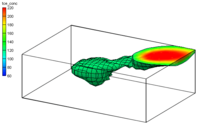GMS:Inverse Distance Weighted: Difference between revisions
No edit summary |
No edit summary |
||
| Line 16: | Line 16: | ||
[[Category:2D Scatter Point]] | [[Category:2D Scatter Point]] | ||
[[Category:3D Scatter Point]] | [[Category:3D Scatter Point]] | ||
[[Category: | [[Category:Interpolation Dialogs]] | ||
{{stub}} | {{stub}} | ||
Revision as of 22:10, 8 December 2015
One of the most commonly used techniques for interpolation of point data is inverse distance weighted (IDW) interpolation. Inverse distance weighted methods are based on the assumption that the interpolating surface should be influenced most by the nearby points and less by the more distant points. The interpolated surface is a weighted average of the point data; the weight assigned to each point diminishes as the distance to the interpolation location increases. Several options are available for inverse distance weighted interpolation. The options are selected using the IDW Interpolation Options dialog. This dialog is accessed through the Options button next to the Inverse distance weighted item in the Interpolation Options dialog. The options in the dialog are as follows:
| [hide] GMS – Groundwater Modeling System | ||
|---|---|---|
| Modules: | 2D Grid • 2D Mesh • 2D Scatter Point • 3D Grid • 3D Mesh • 3D Scatter Point • Boreholes • GIS • Map • Solid • TINs • UGrids | |
| Models: | FEFLOW • FEMWATER • HydroGeoSphere • MODAEM • MODFLOW • MODPATH • mod-PATH3DU • MT3DMS • MT3D-USGS • PEST • PHT3D • RT3D • SEAM3D • SEAWAT • SEEP2D • T-PROGS • ZONEBUDGET | |
| Aquaveo | ||

